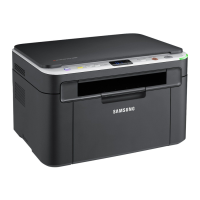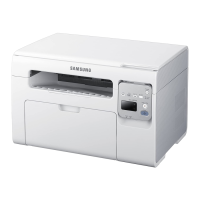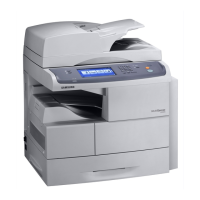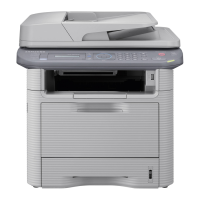Network setup (SCX-3205W(K) only)_ 34
21. Enter the queue name in the Queue input field. If you cannot determine
the queue name for your machine server, try using the default queue
first.
22. For Mac OS X
10.3, if Auto Select does not work properly, select
Samsung in Printer Model and your machine name in Model Name.
• Fo
r Mac OS X 10.4, if Auto Select does not work properly, select
Samsung in Print Using and your machine name in Model.
• For Mac OS X 10.5~10.6, if Auto Select does not work properly,
choose Select Printer Software and your machine name in Print
Using.
Your machine appears on the Printer List,
and is set as the default
machine.
23. Click Add.
If the printer driver does not work properly, uninstall the driver and
reinstall it.
Follow steps below to uninstall the driver for Macintosh.
a) Ma
ke sure that the machine is connected to your computer and
powered on.
b) In
sert the supplied software CD into your CD-ROM drive.
c) Doub
le-click CD-ROM icon that appears on your Macintosh
desktop.
d) Double-click the MAC_Installer folder.
e) Doub
le-click the Installer OS X icon.
f) Ente
r the password and click OK.
g) The
Samsung Installer window opens. Click Continue.
h) Read
the license agreement and click Continue.
i) Click Agr
ee to agree to the license agreement.
j) Select Unins
tall and click Uninstall.
k) Whe
n the message which warns that all applications will close on
your computer appears, click Continue.
l) Whe
n the uninstall is done, click Quit.
Linux
Install Linux Driver and add network Printer
1. Make sure that the machine is connected to your network and
powered on. Also, your machine’s IP address should have been set.
2. Down
load the Unified Linux Driver package from the Samsung
website.
3. Extra
ct the UnifiedLinuxDriver.tar.gz file and open the new directory.
4. Dou
ble-click the Linux folder.
5. Dou
ble-click the install.sh icon.
6. Th
e Samsung Installer window opens. Click Continue.
7. Th
e Add printer wizard window opens. Click Next.
8. Select Network printer and
click Search button.
9. Th
e Printer’s IP address and model name appears on list field.
10. Sele
ct your machine and click Next.
11. Input th
e printer description and Next
12. Wh
en the add printer is done, click Finish
13. Wh
en the install is done, click Finish
Add network Printer
1. Double-click the Unified Driver Configurator.
2. Cli
ck Add Printer…
3. Th
e Add printer wizard window opens. Click Next.
4. Select Network printer
and click the Search button.
5. The
printer’s IP address and model name appears on list field.
6. Select y
our machine and click Next.
7. In
put the printer description and Next
8. Whe
n the add printer is done, click Finish.
IPV6 CONFIGURATION
TCP/IPv6 is supported properly only in Windows Vista or higher.
If the IPv6 network seems to not be working, set all the network setting
to the factory defaults and try again (See "Restoring factory default
settings" on page 32).
In the IPv6 network environment, follow the ne
xt procedure to use the IPv6
address.
1. C
onnect your machine to the network with a network cable.
2. T
urn on the machine.
3. Print a Netw
ork Configuration Report from the machine’s control
panel that will check IPv6 addresses (See "Printing a network
configuration report" on page 30).
4. Select Start > Co
ntrol Panel > Hardware and Sound > Printer > Add
Printer.
5. Click Ad
d a local printer on the Add Printer windows.
6. F
ollow the instruction on the window.
7. Th
e Add Printer Wizard window appears. Follow the instruction on the
window.
If the machine does not work in the network environment, activate
IPv6. Refer to the next section followed by.
Printing a network configuration report
You can print a network configuration report from the machine’s control
panel that will show the current machine’s network settings. This will help
you to set up a network and troubleshoot problems.
1. In read
y mode, press and hold Stop/Clear button on the control
panel for long enough (about four seconds) until the Status LED blinks
fast.
2. T
hen, release the button.
Using this Netw
ork Configuration Report, you can find your machine MAC
address and IP address.
For example:
• MAC Addre
ss:00:15:99:41:A2:78
• IP Address:192
.0.0.192
Setting IPv6 addresses
Machine supports the following IPv6 addresses for network printing and
managements.
• L
ink-local Address: Self-configured local IPv6 address (Address starts
with FE80).
• Stat
eless Address: Automatically configured IPv6 address by a
network router.
• Stateful Address: IPv6 address configured by a DHCPv6 server.
• Ma
nual Address: Manually configured IPv6 address by a user.

